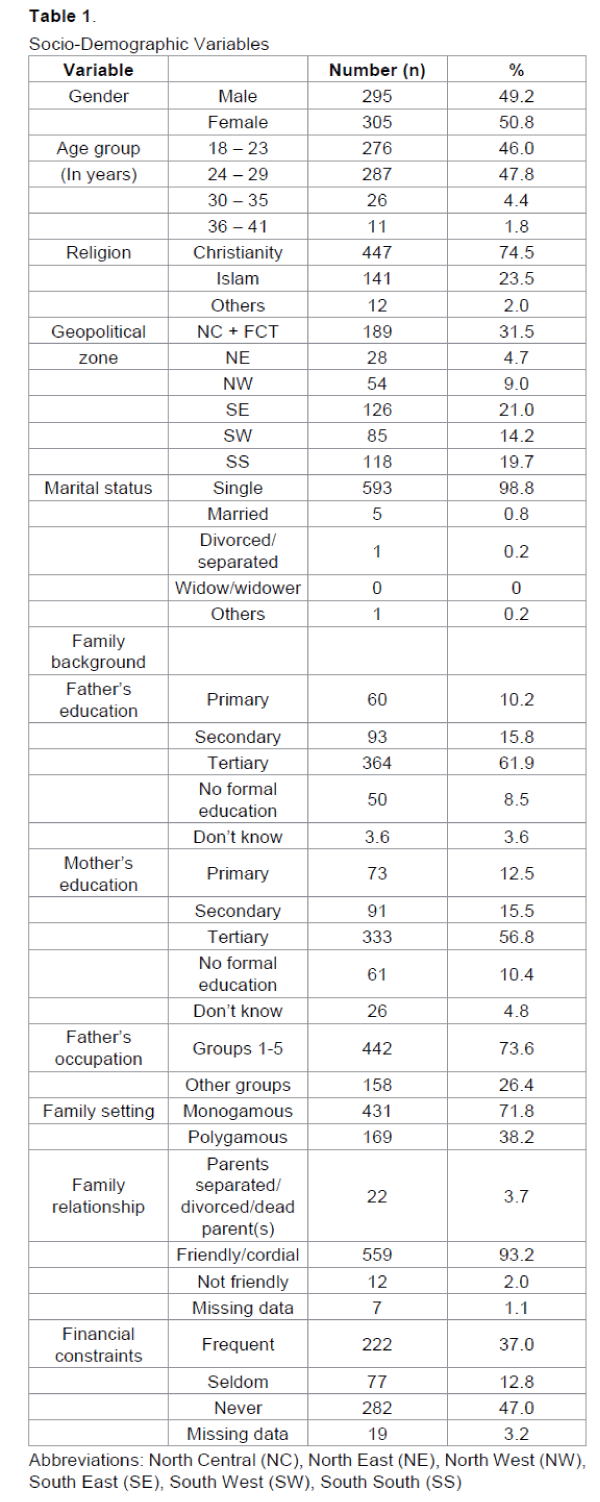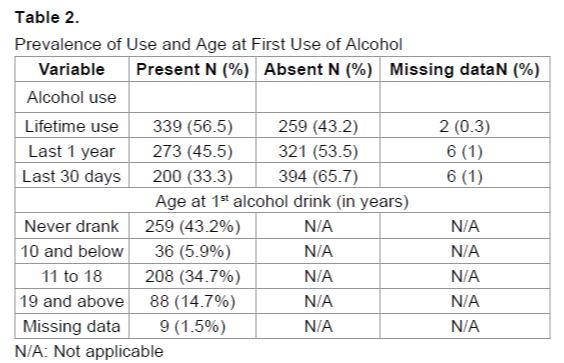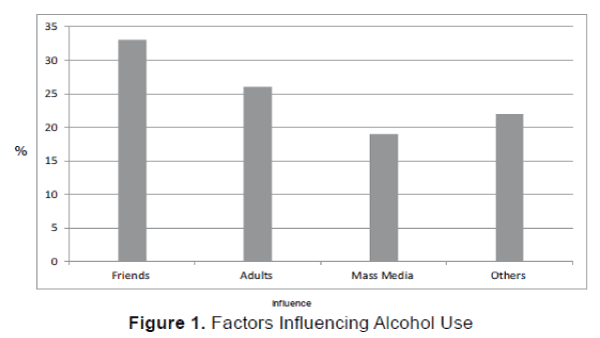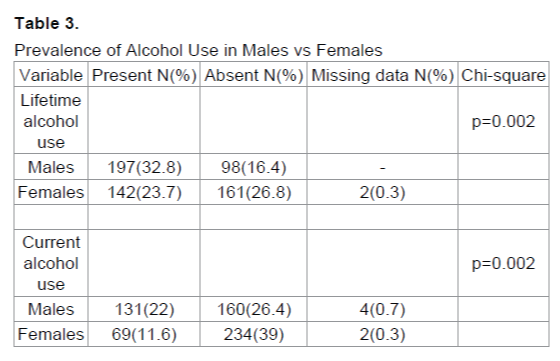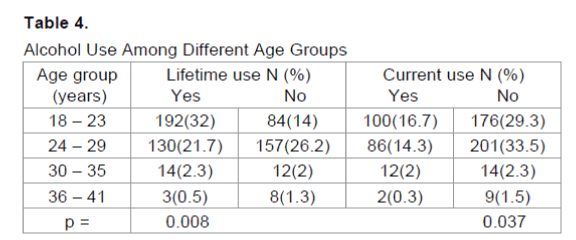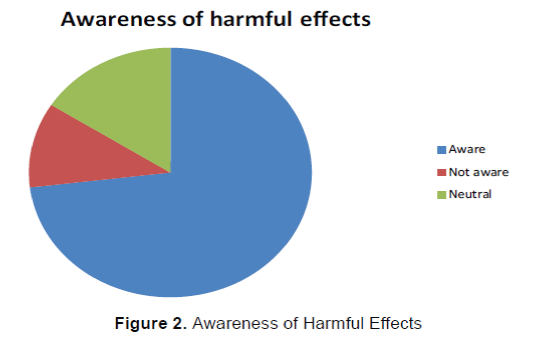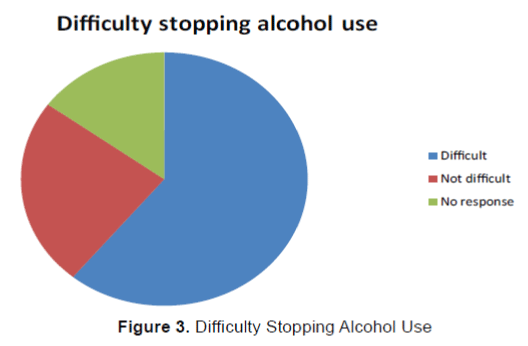Research Article Open Access
Alcohol Use Among Full-Time Students of the University of Abuja
Chikezie U Eze1* and Uchendu I Uzoeghe2
1Department of Mental Health, Faculty of Clinical Sciences, Niger Delta University, Amassoma, Bayelsa state, Nigeria
2Department of Internal Medicine (Psychiatry), University of Abuja Teaching Hospital, Gwagwalada, Abuja (FCT), Nigeria
Visit for more related articles at International Journal of Emergency Mental Health and Human Resilience
Abstract
Alcohol is a common and avoidable cause of morbidities and mortalities among students and the general population globally. The use of alcohol is on the increase, both in quantity and prevalence, in developing countries, including Nigeria. Thus it is very important to explore the use extensively among students, especially in tertiary institutions. Methods: We investigated the use of alcohol among 3rd and 4th year students from different faculties in the University of Abuja. This was a cross-sectional study in which 600 students were randomly selected to participate. The instruments were made up of a socio-demographic questionnaire and the World Health Organization (WHO) questionnaire for student drug use surveys. Data was analysed using SPSS-16. Results: Lifetime and current use of alcohol were 56.5% and 33.3% respectively; and were higher among males, adolescents/young adults and those from dysfunctional homes. While students are aware of the harmful effects of alcohol, they have difficulties stopping its’ use. Conclusion: The rates of lifetime and current alcohol use among university students are high. Appropriate measures and interventions have to be instituted to address these issues.
Keywords
Alcohol use, university students, Abuja
Introduction
Psychoactive substances are chemical substances that, when taken, have the ability to change an individual’s consciousness, mood or thinking processes (WHO, 2004). Alcohol is among the commonest psychoactive substances used (Ihezue, 1988; Adelekan et al., 1993; Akindutire & Adeboyega, 2012; Daramola, 2004; Yakasai, 2010; Yusuf, 2010). It is socially accepted and serves as ‘gateway’ to the use of other substances. As such young people begin experimenting with alcohol and cigarette (Adelekan et al., 1993). Factors such as peer pressure, dysfunctional home settings, advertisement and inability to cope with stress have been associated with onset of substance use (Adelekan et al., 1993; Salaudeen et al., 2011).
Alcohol use and its negative effects on health are very high among the general population globally. Among students, continuous and excessive use has been linked to poor academic performance and school drop-out (Ukwayi et al., 2013; Wechsler, 1995). Alcohol is a leading cause of morbidity and mortality among college students in the United States (Hingson et al., 2005). Several studies have shown very high rates of alcohol use and abuse among students in secondary and tertiary institutions in Nigeria (Awoyinfa, 2012; Kypri et al., 2001; Odejide, 1989; Pela, 1989; Abiodun et al., 1994). Some of these studies have also found that alcohol use begins in childhood or early adolescence.
University students are vital to every nation and their wellbeing and health are essential to national development. Alcohol use, especially when excessive and uncontrollable, is a major threat to students’ academic performance and their future. Since this can be prevented or it’s negative effects limited, it is thus important to study the extent of these problems among students in universities and other tertiary institutions. As stated above, a lot of studies have been conducted on alcohol use among student populations in Nigeria and other places. However, few have been conducted in the northern part of the country. It is common believe in Nigeria that people in the north drink excessively though not scientifically studied or documented. Hence it is also important to study alcohol use among university students in the northern parts of the country as has been extensively done in the south.
The general aim of this study is to determine the prevalence of alcohol use among higher level students in the University of Abuja.
Specific objectives are to determine the factors associated with use of alcohol among the study population.
In conducting this study we aimed at answering the following major research questions:
1. Is the prevalence of alcohol use among 3rd and 4th year students of the University of Abuja significant/high?
2. Is there any difference in rates of alcohol use between students of different geopolitical regions?
3. Are the students who use alcohol aware of the harmful effects of alcohol?
The following null hypotheses were formulated in answering the above questions:
1. The prevalence of alcohol use among 3rd and 4th year students of the University of Abuja is not significant/high?
2. There is no difference in the rates of alcohol use between students of different geopolitical regions of the country.
3. There is no significant awareness of the harmful effects of alcohol use among the students who use alcohol.
Operational Definitions
1. Lifetime prevalence – use of alcohol by respondents at any time in their lives to date.
2. 1 year prevalence – use of alcohol by respondents within the last year before time of interview.
3. Current use – use of alcohol within the last 30 days before interview.
Methods and Materials
Location and Participants
The study was conducted at the mini-campus of the University of Abuja, located at Gwagwalada. Abuja is the Federal Capital Territory (FCT) and the capital of Nigeria. It is located in the north central zone and inhabited by a population of about 776,298 people. The University admits students from the Federal Capital Territory and the 36 states of Nigeria as well as the neighbouring countries. It is relatively new; hence only 6 Faculties are fully developed.
The estimated sample size from our calculation was close to 500. However, we decided to increase the sample to 624 participants using a multistage sampling technique. There were 6 functional faculties in the University as at the time of this study. So we randomly selected 2 departments from each faculty and 52 participants from each department with equal gender representation because the populations of male and female students were close but females slightly higher. So we were supposed to have a total of 624 participants but we ultimately got 615 participants who were willing to take part in the study. Only full-time students in their 3rd and 4th year of study and who gave their consent were selected. The total population of full time students at time of study was 8,307. About 40% of them were in year 3 or 4. Part-time students were excluded because they were considered to have other interests apart from studying and they were more difficult to reach. Year 1 and 2 students were excluded because they were considered new in the university system. Students who refused consent were also excluded from the study.
Ethical Considerations
Permission for the study was obtained from the ethics committee and authorities of the University of Abuja. Written informed consent was also gotten from the participants after clear education on the need for the study and their rights to give or refuse consent. All data were handled with strict confidentiality.
Instruments Used for the Study
A questionnaire was designed for collection of sociodemographic data of the participants. These include biodata, family structure, father’s occupation and family status amongst others.
Question 8 of the World Health Organization (WHO) Questionnaire for Student Drug use Surveys was used to collect data on current, 1 year and lifetime use of alcohol among the participants. This questionnaire has 3 sections and has been used in other studies on psychoactive substance use (Adelekan, 1989; Fatoye, 1998). These instruments are self administered and were pretested before the commencement of the study.
Procedure of Data Collection
The authors were both involved in the process of data collection. Also, 2 research assistants were engaged and trained by the authors to aid data collection. The authors had initially visited the various faculties and departments for preliminary sensitizations and consents prior to commencement of the study. Participants selected were approached on lecture days in their departments and requested to fill the questionnaires, which took a maximum of about 10 to 15 minutes to fill. The authors and research assistants gave necessary assistance when required and double-checked to ensure adequate information was given. This process was continued till the required sample size was met. The study was commenced in September 2012 and duration of data collection was about 2 months.
Data Analysis
Data collected were recorded and analysed using the Statistical Package for Social Sciences version 16 (SPSS-16). Chi-square was used to analyse categorical variables while student’s t-test and analysis of variance were used for continuous variables. Level of significance was set at 0.05 and below. Results are presented in charts and tables.
Results
A total of 615 questionnaires were given to the participants but only 600 participants’ questionnaires were finally analysed. Fifteen (15) questionnaires were rejected due to poor completion, inconsistent or conflicting data. The response rate was therefore 97.6%. The males were 295(49.5%) while females were 305(50.8%). Their ages ranged between 18-41 years with a total average age of 23.2 ± 3.39 years. The mean age of males was 23.98 years while that of females was 22.45 years. The males were significantly older (t=5.52, p<0.003). Most of the participants (93.8%) were within ages 18 and 29 years. Christianity was the most common religion (74.5%) and most of the participants (31.5%) were from the North Central geopolitical zone and the FCT. The participants were mostly from monogamous homes (71.8%) and homes in which family relationships are stable and cordial (94.3%). 5.7% were from dysfunctional homes. Five hundred and ninety-three (98.8%) were single or never married. More of the participants (59.4%) had parents with tertiary education and were from either the upper or middle socioeconomic strata based on their fathers’ occupation. The socio-demographic information of participants is shown in Table 1.
The lifetime prevalence of alcohol use is 56.5% (339), while the 1 year and 30 days rates are 45.5% (273) and 33.3% (200) respectively. Majority of those who used alcohol had their first drink between the ages of 11 and 18 years (Table 2).
They were influenced into drinking alcohol mostly by friends (33%), watching adults (26%) and mass media (19%) respectively, amongst others (Figure 1).
Current use of alcohol was highest among males; those aged 18 to 23 years, from the North Central geopolitical zone and those from dysfunctional and polygamous homes. No significant association found between current use of alcohol and marital status, religion and year of study or faculty of study (Tables 3 and 4).
Majority of those who have ever used alcohol (73.1%) are aware of some of its’ harmful effects; majority of current users’ are willing to stop but find it difficult to do so (61%) (Figures 2 and 3).
Null Hypotheses Results
1. The prevalence of alcohol use among 3rd and 4th year students of the University of Abuja is not significant/high? Result: the results show that the current, 1 year and lifetime prevalence of alcohol use are 33.3%, 45.5% and 56.5% respectively. These figures are high and significant. Thus we reject the null hypothesis. There are high rates of alcohol use among students of the University of Abuja.
2. There is no difference in the rates of alcohol use between students of different geopolitical regions of the country. Result: chi square analysis got p-value 0.055. though this is not statistically significant, participants from the North central zone used alcohol most. Based on the result, we accept the null hypothesis and state that there is no significant difference in the use of alcohol between students from different geopolitical zones.
3. There is no significant awareness of the harmful effects of alcohol use among the students who use alcohol. Result: 73.1% of participants who used alcohol are aware of its harmful effects but still use alcohol. We reject the null hypothesis and submit that there is significant reported awareness of the harmful effects of alcohol among the participants who drink.
Discussion
The data showed that there were more female than male participants. This reflected the proportion in the total students’ population. This is contrary to other studies on substance use among students in tertiary institutions which showed male dominances in populations (Daramola, 2004; Onofa, 2006). The admission policy of the university could account for this difference. The lifetime and current use of alcohol were found to be 56.5% and 33.3% respectively. Similar and slightly higher rates have been previously reported (Essien, 2010; O’Malley, 2002). The minor differences in the rates of alcohol use reported by the different studies could be due to differences in methodologies and study populations. However, they all indicate high rates of alcohol use among students of higher learning. Current alcohol use was higher among males. Some studies have also reported higher prevalence of alcohol use among males (Ukwayi et al., 2013; Okogbenin, 2008). Males are generally more daring and adventurous; as such, more likely to use alcohol and other psychoactive substances. Most respondents used alcohol for the first time between the ages of 11 and 18 years. Similar ages of onset have also been previously documented (Ukwayi et al., 2013; Okogbenin, 2008). This is the adolescence age group when most people are very active, energetic and seeking new experiences. Adolescents are also prone to external influences as we found that most of them were influenced into using these substances by friends or watching adults, who also use these substances; this has also been previously reported (Akindutire & Adeboyega, 2012). This therefore emphasizes the importance of promoting positive influences especially on adolescents. However, current use of alcohol was found to be commonest among those aged 18 to 23 years. This was also reported previously (Ukwayi et al., 2013).
Participants from polygamous homes and dysfunctional families were found to be taking alcohol currently, more than those from monogamous and/or stable families. Another study had found higher rates of alcohol use in general among students from polygamous, unstable or broken homes than those from monogamous or stable homes with cordial family relationship (Essien, 2010; Fatoye, 1998). It is easily appreciated that children from monogamous and stable homes are likely to receive more care and attention than those from polygamous and dysfunctional homes who are exposed to diverse influences. No significant difference was found in the rates of current alcohol use between the 3rd and 4th year students. It could be because both share almost similar campus exposures and experiences. Perhaps there may be differences between them and students at lower levels. This has to be explored in others studies. Current alcohol use was highest among participants from the North central zone of the country. Possible reasons for this observation have to be further explored. They could be due to individual and collective attributes of these students and not necessarily due to academic burden/stress.
Majority of students who have used or still using alcohol are aware of some of the major harmful effects. This study however did not focus on specific harmful effects. The questionnaire just asked if the students knew alcohol is harmful or not. It would have been more useful if knowledge of specific harms was documented. Most of the students also report to have difficulties stopping the habit as has been previously reported (Okogbenin, 2008). This underscores the importance of studying the extent of alcohol among students with the aim of instituting relevant and appropriate interventions to help them.
The limitations of this study as observed are that it was restricted to only full time and 3rd/4th year students. However, the reasons for these have been stated. The findings are reflective of what obtains among university students.
Conclusion and Recommendations
Alcohol use is very common among students, especially in universities and other higher institutions all over the world. The trends are increasing in Nigeria and other developing countries. Also students have difficulties stopping habitual use of alcohol. In view of the well-documented and avoidable morbidities and mortalities associated with the use of alcohol, it is important to extensively study the extent of use and associated factors among students of higher learning, as to have comprehensive data to enable planning and implementation of appropriate programmes and interventions to protect and improve their health and well-being. It is also recommended that mental health and counselling programmes be incorporated into the universities health care system to cater for these needs.
Competing Interests
The authors declare that they have no competing interest.
Authors’ Contributions
Both authors contributed at all stages in the conceptualization and conduct of the study. Specifically, UIU initiated the study and did the preliminary literature search and methodology. CUE did the data collation, analysis and final write-up. Both read through and approved the final manuscript.
Acknowledgement
The authors wish to thank all participants and the authorities of the University of Abuja for their roles in making this study possible.
References
- Abiodun, O.A., Adelekan, M.L., Ogunremi, O.O., &Oni, G.A. (1994).Pattern of substance use among secondary school students in llorin, Northern Nigeria.West African Journal of Medicine,13, 91-97
- Adelekan, M.L., Abiodun, O.A., Obayan, A.I., Oni, G.A., &Ogunremi, O.O. (1993). Psychosocial correlates of alcohol, tobacco and cannabis use findings from a Nigerian University. Drug and Alcohol Dependence,33(3), 247-256
- Adelekan M.L. (1989). Self- reported drug use among secondary school students in the Nigerian state of Ogun. Bulletin on Narcotics,41, 109-116.
- Akindutire, I.O., &Adegboyega, J.A. (2012).Psychoactive Substance Consumption and Awareness of Health Effects among Students in Tertiary Institutions in Ekiti State, Nigeria.Journal of Emerging Trends in Educational Research and Policy Studies,3(3), 257-262.jeteraps.scholarlinkresearch.org. Accessed 10 March, 2014.
- Awoyinfa, J.O. (2012). An Investigation into the Incidence of Alcohol Usage and Abuse among Female Student of the University of Lagos, Nigeria, West Africa.Journal of Emerging Trends in Educational Research and Policy Studies, 3(2), 174-178.
- Daramola, T.O. (2004). Psychoactive Substance Use among Medical Students of University of Ilorin. A Dissertation submitted to the National Postgraduate Medical College of Nigeria, Faculty of Psychiatry.
- Essien, C.F. (2010). Drug use and Abuse among students in tertiary institutions – The Case of Federal University of Technology, Minna.Journal of Research in National Development, 8(1), 35- 42.
- Fatoye, F.O. (1998). Co-occurrence of study difficulty, drug use and psychopathology among secondary school students in Ilesha, Western Nigeria. A Dissertation submitted to the National Postgraduate Medical College of Nigeria, Faculty of Psychiatry.
- Federal Ministry of Education (1995). Basic factors on drug abuse for guidance counsellors. Pamphlets, pp. 1-13.
- Hingson R, Heeren T, Winter M, Wechsler H (2005): Magnitude of alcohol-relatedmortality and morbidity among U.S. college students ages 18-24:changes from 1998 to 2001. Annual Review of Public Health, 26, 259-279.
- Ihezue, U.H. (1988). Drug abuse among medical students at a Nigerian University: part 1. Prevalence and pattern of use.Journal of the National Medical Association, 80(1), 81-85.
- Kypri, K., Paschall, M.J., Langley, J., Baxter, J., Cashell-Smith, M., &Bourdeau, B. (2009).Drinking and alcohol-related harm among New Zealand university students: findings from a national Web-based survey.Alcoholism: Clinical and Experimental Research,33(2), 307-314.
- Odejide, O.A. (1989). A Nation at Risk: Alcohol and Substance Abuse Among Nigerian Youths. University of Ibadan Inaugural Lecture, Ibadan, Nigeria.
- Okogbenin, E. (2008). Prevalence and Correlates of Alcohol use/abuse among adolescents secondary school students in Benin City. A Dissertation submitted to the West Africa College of Physicians, Faculty of Psychiatry.
- O'Malley, P.M., &Johnston, L.D. (2002).Epidemiology of Alcohol and Other Drug Use among American College Students.Journal of Studies on Alcohol and Drugs, Supplement, No. 14, 23- 39.
- Onofa L (2006). Prevalence and pattern of drug abuse among students of three tertiary institutions in Abeokuta. A Dissertation submitted to the West Africa College of Physicians.
- Pela, O.A. (1989). Drug use and attitudes among College Students in Benin City, Nigeria.Journal of Alcohol and Drug Education, 34(3), 5-13.
- Salaudeen, A., Musa, O., Akande, T., &Bolarinwa, O. (2011).Effects of health education on cigarette smoking habits of young adults in tertiary institutions in a northern Nigerian state.Health Science Journal, 5(3), 216-228.
- Ukwayi, J.K., Ambekeh, L.U., Uwanede, C.C., &Undelikwo, V.A. (2013).Alcohol abuse as a cause of poor academic performance among Social Science Students of the University of Calabar, Nigeria.Mediterranean Journal of Social Sciences, 4(1), 413-22
- Wechsler, H. (1995). Binge Drinking on American College Campuses: A New Look at an Old Problem. Boston, MA: Harvard School of Public Health
- WHO.(2004). Neuroscience of Psychoactive Substance use and dependence. Switzerland, Tushita Graphic Vision. Accessed 10 March 2014.www.who.int/substance_abuse/publications/en/Neuroscience.pdf
- Yakasai, B.A. (2010). The menace of drug abuse.The Nigerian Airforce Magazine, 17(1), 89-93
- Yusuf, F.A. (2010). Factors influencing substance abuse among undergraduate students in Osun State.African Research Review, 4(17), 330-340.
Relevant Topics
Recommended Journals
Article Tools
Article Usage
- Total views: 16043
- [From(publication date):
March-2015 - Apr 06, 2025] - Breakdown by view type
- HTML page views : 11104
- PDF downloads : 4939

